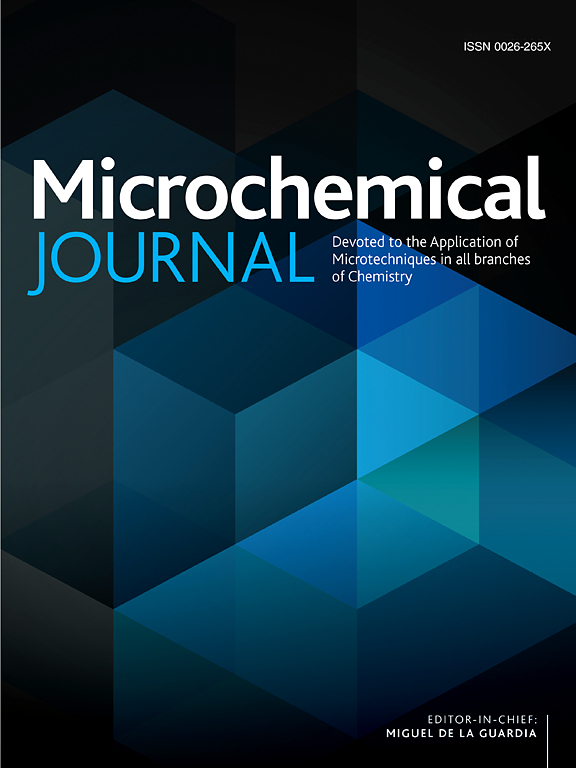用量子点包封分子印迹聚合物检测藏红花素作为藏红花质量评价的替代方法
IF 4.9
2区 化学
Q1 CHEMISTRY, ANALYTICAL
引用次数: 0
摘要
分子印迹聚合物(MIPs)是通过模板分子、功能单体、交联剂和溶剂之间的相互作用合成的,具有选择性识别能力,被广泛应用。在这项研究中,用碳量子点(CQDs)封装的MIPs用于检测藏红花素,藏红花素是一种生物活性类胡萝卜素,负责藏红花鲜艳的颜色。采用热裂解法合成了CQDs,并用TEM、FTIR、XRD、XPS和荧光光谱对其进行了表征。将CQDs与功能单体和交联剂整合,然后去除模板,制备了MIP-CQDs纳米复合材料。还合成了比较非印迹聚合物(NIPs)。该纳米复合材料具有优异的光学和形态学性能,荧光猝灭用于评价藏红花素的相互作用。mip - cqd在2 ~ 175 μM的线性范围内对藏红花素具有较高的灵敏度和选择性,检出限为2.1 μM。最佳条件为pH 7.0,孵育时间5分钟。该荧光猝灭机制归因于藏红花素和MIP-CQDs之间的福斯特共振能量转移(FRET)。值得注意的是,MIP-CQDs对结构相似的化合物和共存离子的干扰具有很强的抵抗能力,确保了在复杂基质中的可靠性能。这项研究强调了定制纳米复合材料设计对于推进分子传感应用的重要性。本文章由计算机程序翻译,如有差异,请以英文原文为准。
Synthesis of molecularly imprinted polymer encapsulated with quantum dots for detection of crocin as an alternative approach for quality estimation of saffron
Molecularly Imprinted Polymers (MIPs) are widely used for their selective recognition capabilities, synthesized through interactions between template molecules, functional monomers, crosslinkers, and solvents. In this study, MIPs encapsulated with Carbon Quantum Dots (CQDs) were synthesized for detection of crocin, a bioactive carotenoid responsible for saffron’s vivid colour. CQDs were synthesized via thermal pyrolysis and characterized using TEM, FTIR, XRD, XPS, and fluorescence spectroscopy. The MIP-CQDs nanocomposite was prepared by integrating CQDs with functional monomers and crosslinkers, followed by template removal. Comparative non-imprinted polymers (NIPs) were also synthesized. The nanocomposites exhibited excellent optical and morphological properties, with fluorescence quenching used to evaluate crocin interaction. The MIP-CQDs displayed high sensitivity and selectivity for crocin in a linear range of 2–175 μM, with a detection limit of 2.1 μM. Optimal conditions included pH 7.0 and a 5-minute incubation time. The fluorescence quenching mechanism was attributed to Forster Resonance Energy Transfer (FRET) between crocin and MIP-CQDs. Notably, MIP-CQDs showed strong resistance to interference from structurally similar compounds and co-existing ions, ensuring reliable performance in complex matrices. The study underscores the significance of tailored nanocomposite designs for advancing molecular sensing applications.
求助全文
通过发布文献求助,成功后即可免费获取论文全文。
去求助
来源期刊

Microchemical Journal
化学-分析化学
CiteScore
8.70
自引率
8.30%
发文量
1131
审稿时长
1.9 months
期刊介绍:
The Microchemical Journal is a peer reviewed journal devoted to all aspects and phases of analytical chemistry and chemical analysis. The Microchemical Journal publishes articles which are at the forefront of modern analytical chemistry and cover innovations in the techniques to the finest possible limits. This includes fundamental aspects, instrumentation, new developments, innovative and novel methods and applications including environmental and clinical field.
Traditional classical analytical methods such as spectrophotometry and titrimetry as well as established instrumentation methods such as flame and graphite furnace atomic absorption spectrometry, gas chromatography, and modified glassy or carbon electrode electrochemical methods will be considered, provided they show significant improvements and novelty compared to the established methods.
 求助内容:
求助内容: 应助结果提醒方式:
应助结果提醒方式:


